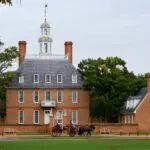Further your knowledge of the American Civil War through five exceptional novels that give you some taste of what life would have been like during the days of the war. Each work, from Stephen Crane’s famous psychological exploration to Sebastian Barry’s lyrical narrative, offers a unique take on the conflict’s complexities.
These stories capture all the classic themes of great war fiction: courage, strategy, and the human spirit at its most noble and at its most flawed.
If you’re feeling inspired to take your study of the Civil War to a new level, consider booking a place on one of our Civil War Battlefield Tours in Virginia.

The Red Badge of Courage by Stephen Crane
Stephen Crane’s The Red Badge of Courage is a seminal American novel delving into the psychological turmoil of young soldier Henry Fleming during an unnamed Civil War battle.
Without having experienced war himself, Crane remarkably managed to capture the visceral reality of the battlefield, making the novel a pioneering work in realistic war fiction. Through Fleming’s internal struggle, Crane explores the themes of fear, bravery, and the quest for self-identity amidst the chaos of war.
The novel’s vivid, often brutal imagery and its exploration of the soldier’s psyche provide a raw, unromanticized view of combat. This is undoubtedly the most famous American Civil War novel ever written, and it remains as powerful a meditation on war as it was when first published.
If you’re interested in learning more about Stephen Crane, we recommend Paul Auster’s recent biography, Burning Boy: The Life and Work of Stephen Crane.

The Killer Angels by Michael Shaara
The Killer Angels by Michael Shaara is a masterful recreation of the pivotal Battle of Gettysburg, told through the perspectives of key historical figures. Shaara’s novel stands out for its detailed character development and authentic portrayal of military strategy, offering a narrative that is both educational and profoundly human.
The book focuses on the moral dilemmas and leadership challenges faced by figures such as Robert E. Lee, James Longstreet, and Joshua Lawrence Chamberlain, providing insight into their thoughts and motivations. Shaara’s meticulous attention to historical detail and his ability to humanize these historical giants lend the narrative a gripping sense of realism. The novel was justly awarded the Pulitzer Prize for Fiction in 1975.
Cain at Gettysburg by Ralph Peters
Ralph Peters’ Cain at Gettysburg is a more recent Civil War novel that rivals Shaara’s work for its moving portrayal of the Battle of Gettysburg. Peters combines rigorous historical research with vivid storytelling to capture the gritty reality of one of the Civil War’s most crucial engagements from the perspective of the soldiers on the field.
The novel’s strength lies in its detailed depiction of the battlefield, from the strategies of commanding generals to the personal experiences of the foot soldiers. Peters does not shy away from the brutality of war, presenting a narrative that is both authentic and deeply troubling.
The characters, both fictional and historical, are well-developed, showcasing the diversity of experiences and perspectives within the Union and Confederate armies. Cain at Gettysburg stands as a testament to the chaos, brotherhood, and heroism of war. And there’s good news if you enjoy the novel as much as we did: Peters has gone on to write a further five Civil War novels, each as brilliant as the next.
Days Without End by Sebastian Barry
Sebastian Barry’s Days Without End is a unique and poetic exploration of the American Civil War, told through the eyes of Thomas McNulty, an Irish immigrant who finds love and family amidst the turmoil of war. Barry’s novel is distinguished by its lyrical prose and the deep humanity of its characters, who navigate issues of identity, belonging, and survival in a landscape marked by violence and change.
The relationship between Thomas and his fellow soldier, John Cole, forms the heart of the story, offering a poignant reflection on love and resilience in the face of adversity. Barry’s depiction of the Civil War and the Indian Wars that followed presents a sweeping narrative of American history, characterized by its vivid imagery and emotional depth.
We’re sure you’ll find Barry’s sparkling prose as enchanting as we do. In 2020, Barry wrote a follow-up novel, A Thousand Moons, which charts a character’s life in the post-war years.

Shiloh by Shelby Foote
Shelby Foote’s Shiloh brings the Battle of Shiloh to life with the narrative skill of a seasoned historian and the storytelling flair of a novelist. Foote beautifully reconstructs the events of the battle, focusing on the chaos of combat and the personal stories of the men who fought.
The novel presents a balanced view of both the Union and Confederate sides, providing a nuanced understanding of the battle’s complexities and human cost. Foote’s work is notable for its historical accuracy and the depth of its characterizations, making Shiloh an essential read for anyone seeking to comprehend the full scope of the Civil War’s impact.
Through Foote’s lens, the Battle of Shiloh emerges not just as a military conflict but as a pivotal moment in American history. And if you want to spend more time in Foote’s company, you can move on to his truly epic, three-volume, 2,968-page work of historical non-fiction, The Civil War: A Narrative.
Each of our choices offers an original point of view on the Civil War, reflecting the enormity of the conflict’s place in American history. If you’d like to explore some of the war’s key battlefields in the company of expert historian guides, join us on one of our Civil War Battlefield Tours in Virginia.


